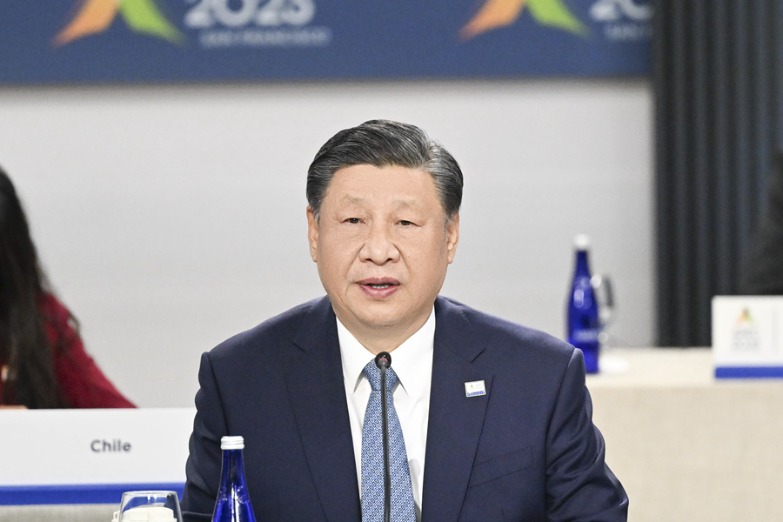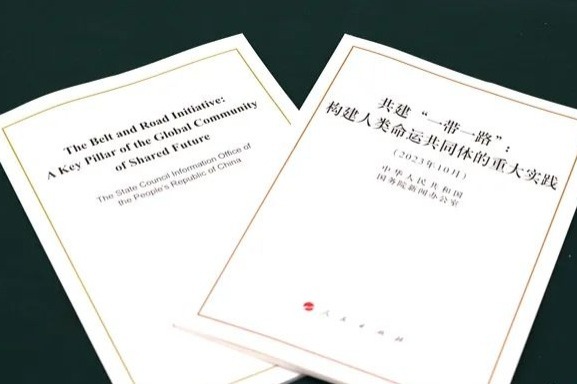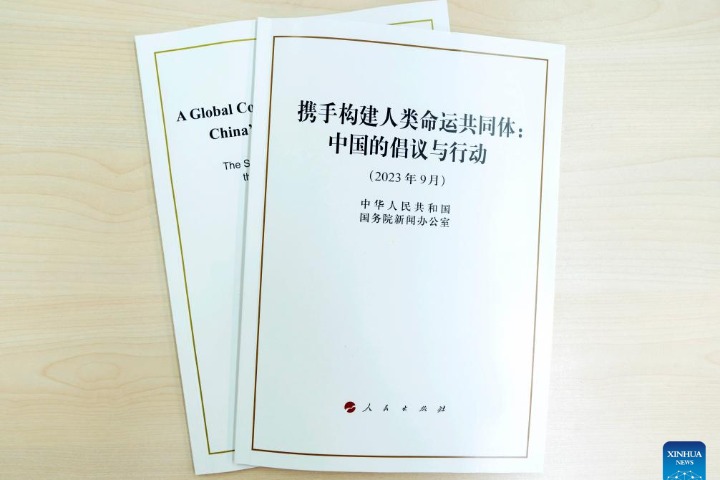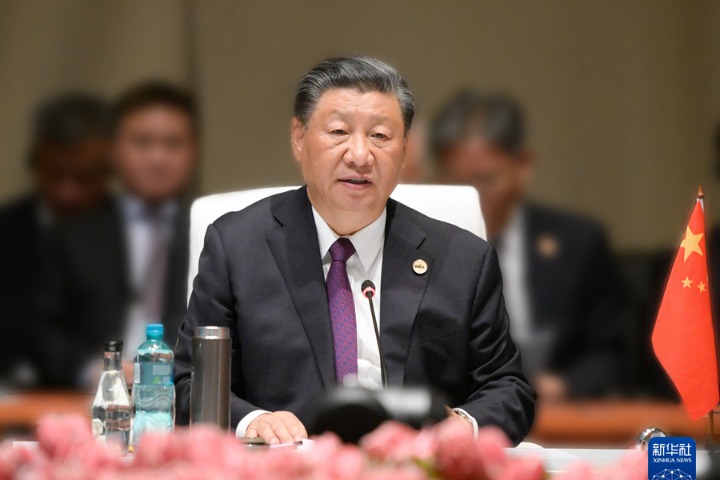《中国的粮食安全》白皮书(双语全文)
新华网 2019-10-15 13:55

二、中国特色粮食安全之路
II. Food Security in China
中国立足本国国情、粮情,贯彻创新、协调、绿色、开放、共享的新发展理念,落实高质量发展要求,实施新时期国家粮食安全战略,走出了一条中国特色粮食安全之路。
Based on its own national conditions and food availability, China has embarked on a road to establishing food security in its own way by implementing the concepts of innovative, coordinated, green, open, and inclusive development, the requirements of high-quality development, and a national food security strategy for a new era.
(一)稳步提升粮食生产能力
1. Steadily increasing grain production capacity
——严守耕地保护红线。实施全国土地利用总体规划,从严管控各项建设占用耕地特别是优质耕地,健全建设用地“增存挂钩”机制,实行耕地占补平衡政策,严守12000万公顷耕地红线。全面落实永久基本农田特殊保护制度,划定永久基本农田10300多万公顷。目前,全国耕地面积13488万公顷,比1996年增加480多万公顷,粮食作物播种面积达到11700多万公顷,比1996年增加450万公顷左右,夯实了粮食生产基础。
- Never crossing the red line for the protection of cultivated land. The Chinese government has implemented an overall plan for land use throughout the country. It strictly controls the occupation of cultivated land, especially high-quality land. It is improving the mechanism for linking the increase and deposit of construction land, and implementing a policy of balancing the occupation and replenishment of arable land, thus drawing a red line for its 120 million hectares of cultivated land. We have implemented a complete and special protection system for permanent basic farmland, and designated more than 103 million hectares of permanent basic farmland. At present, the country has 134.88 million hectares of cultivated land, an increase of more than 4.8 million hectares over 1996. There are more than 117 million hectares sown with grain, an increase of about 4.5 million hectares over 1996. The foundations of grain production have been strengthened.
——提升耕地质量,保护生态环境。实施全国高标准农田建设总体规划,推进耕地数量、质量、生态“三位一体”保护,改造中低产田,建设集中连片、旱涝保收、稳产高产、生态友好的高标准农田。2011年以来累计建成高标准农田4260多万公顷,项目区耕地质量提升1-2个等级,每公顷粮食产量提高约1500公斤,粮食生产能力得到提升。实行测土配方施肥,推广秸秆还田、绿肥种植、增施有机肥、地力培肥土壤改良等综合配套技术,稳步提升耕地质量。实施耕地休养生息规划,开展耕地轮作休耕制度试点。持续控制化肥、农药施用量,逐步消除面源污染,保护生态环境。
- Improving the quality of arable land and protecting the environment. China has implemented an overall plan for the development of high-standard farmland, promoted the protection of quantity, quality and ecology of cultivated land, and upgraded medium-and low-yield fields. It has built high-standard farmland with concentrated contiguous land, guaranteed harvests in drought or flood, stable and high yield, and a sound ecology. Since 2011, we have created more than 42.6 million hectares of high-standard farmland, improved the quality of cultivated land by 1 to 2 grades in related zones, increased grain production by about 1,500 kg per hectare, and increased grain production capacity. We have carried out soil testing and formula fertilization, popularized the practice of returning straw to the field, green manure planting, the application of organic fertilizer, soil improvement and other supporting technologies, and steadily improved the quality of cultivated land. We have also implemented cultivated land rehabilitation planning and carried out a pilot system of fallow rotation of cultivated land. We will continue to control the application of chemical fertilizers and pesticides, gradually eliminate non-point source pollution, and protect the environment.
——建立粮食生产功能区和重要农产品生产保护区。以主体功能区规划和优势农产品布局规划为依托,以永久基本农田为基础,建立粮食生产功能区和重要农产品生产保护区。划定水稻、小麦、玉米等粮食生产功能区6000万公顷,大豆、油菜籽等重要农产品生产保护区近1500万公顷。加强建设东北稻谷、玉米、大豆优势产业带,形成黄淮海平原小麦、专用玉米和高蛋白大豆规模生产优势区;打造长江经济带双季稻和优质专用小麦生产核心区;提高西北优质小麦、玉米和马铃薯生产规模和质量;重点发展西南稻谷、小麦、玉米和马铃薯种植;扩大东南和华南优质双季稻和马铃薯产量规模。优化区域布局和要素组合,促进农业结构调整,提升农产品质量效益和市场竞争力,保障重要农产品特别是粮食的有效供给。
- Establishing functional areas for grain production and protected areas for the production of important agricultural products. In accordance with the planning of the main functional areas and the configuration of superior agricultural products, China has established functional areas for grain production and protected areas for important agricultural products on the basis of permanent basic farmland. We have designated 60 million hectares of functional areas for grain production, such as rice, wheat and corn, and nearly 15 million hectares of protected areas for the production of important agricultural products such as soybeans and rapeseed. We have strengthened the superior industrial belt of rice, corn and soybeans in Northeast China, and formed a dominant area for the large-scale production of wheat, special corn and high-protein soybeans on the North China Plain. We are building a core area for the production of double-cropping rice and high-quality special wheat in the Yangtze River Economic Belt, and we are expanding the scale and improving the quality of high-quality wheat, corn and potatoes in Northwest China. In Southwest China we are focusing on the cultivation of rice, wheat, corn and potatoes, and increasing the yield of high-quality double-cropping rice and potatoes in Southeast and South China. We will continue to optimize the regional configuration and the combination of production factors, promote agricultural restructuring, enhance the quality and efficiency of agricultural products and market competitiveness, and ensure the effective supply of important agricultural products, especially grain.
——提高水资源利用效率。规划建设一批节水供水重大水利工程,开发种类齐全、系列配套、性能可靠的节水灌溉技术和产品,大力普及管灌、喷灌、微灌等节水灌溉技术,加大水肥一体化等农艺节水推广力度。加快灌区续建配套与现代化高效节水改造,推进小型农田水利设施达标提质,实现农业生产水资源科学高效利用。
- Improving the efficiency of water resource utilization. The Chinese government has planned and built a number of major water conservancy projects for water saving and water supply. We have developed a full range of water-saving irrigation technologies and products that are reliable and complementary to each other. We have vigorously popularized water-saving irrigation technologies such as pipe irrigation, sprinkler irrigation and micro-irrigation, and promoted the integration of water and fertilizer and other agronomy water-saving technologies. We will further speed up the installation of support facilities and modern and efficient water-saving reconstruction in irrigation districts, standardize and improve the quality of small-scale irrigation facilities, and realize the scientific and efficient utilization of water resources in agricultural production.
(二)保护和调动粮食种植积极性
2. Cultivating and arousing the enthusiasm of grain planting
——保障种粮农民收益。粮食生产不仅是解决粮食需求问题,更是解决农民就业问题的重要途径和手段。中国农业人口规模巨大,通过城镇化减少农业人口将是一个渐进的过程,在这个过程中必须保障农民的就业和收入。为全面促进农村经济社会的发展,国家相继取消牧业税、生猪屠宰税和农林特产税,特别是在2006年全面取消了在中国存在2600年的农业税,从根本上减轻了农民负担。逐步调整完善粮食价格形成机制和农业支持保护政策,通过实施耕地地力保护补贴和农机具购置补贴等措施,提高农民抵御自然风险和市场风险的能力,保障种粮基本收益,保护农民种粮积极性,确保农业可持续发展。
- Guaranteeing farming incomes. Grain production makes an essential contribution to feeding the people; it also provides employment to farmers. China has a huge agricultural population, and it will be a gradual process to reduce the agricultural population through urbanization, during the course of which the employment and income of farmers must be guaranteed. In order to develop the rural economy and society in an all-around way, China has abolished the animal husbandry tax, pig slaughtering tax, tax on agricultural and forestry specialties and other taxes, especially the agricultural tax, which had existed in China for 2,600 years and was abolished in 2006. All these efforts have fundamentally reduced the burden on farmers.
We will gradually adjust and improve the grain price formation mechanism and agricultural support and protection policies, and improve farmers' ability to resist natural and market risks through the implementation of land fertility protection subsidies for cultivated land and subsidies for the purchase of agricultural machinery and equipment. We will guarantee the basic income of farmers, cultivate their enthusiasm for growing grain, and ensure the sustainable development of agriculture.
——完善生产经营方式。巩固农村基本经营制度,坚持以家庭承包经营为基础、统分结合的双层经营体制,调动亿万农民粮食生产积极性。着力培育新型农业经营主体和社会化服务组织,促进适度规模经营,把小农户引入现代农业发展轨道,逐步形成以家庭经营为基础、合作与联合为纽带、社会化服务为支撑的立体式复合型农业经营体系。目前,全国家庭农场近60万家,农民合作社达到217.3万家,社会化服务组织达到37万个,有效解决了“谁来种地”“怎样种地”等问题,大幅提高了农业生产效率。
- Improving the mode of production and operation. China has consolidated the basic management system in rural areas, adhered to a two-tier management system based on household contract management and combined with unification and division, and aroused the enthusiasm of hundreds of millions of farmers in grain production. We have invested a great effort in cultivating new-type agricultural business entities and socialized service organizations, promoted moderate-scale operations, and guided small-scale farmers onto the track of modern agriculture, gradually forming a three-dimensional compound agricultural management system based on family management, with cooperation as the link, and social services as the support. At present there are nearly 600,000 family farms, 2.17 million farmers' cooperatives, and 370,000 social service organizations in China. The problems of "who farms the land" and "how to farm the land" have been effectively solved, and the efficiency of agricultural production has significantly improved.
(三)创新完善粮食市场体系
3. Innovating and improving the food market system
——积极构建多元市场主体格局。深化国有粮食企业改革,鼓励发展混合所有制经济,促进国有粮食企业跨区域整合,打造骨干粮食企业集团。推动粮食产业转型升级,培育大型跨国粮食集团,支持中小粮食企业发展,促进形成公平竞争的市场环境。积极引导多元主体入市,市场化收购比重不断提高,粮食收购主体多元化格局逐步形成。
- Building a pattern of multiple market players. China is furthering reform of state-owned grain enterprises, encouraging the development of a mixed ownership economy, promoting cross-regional integration of state-owned grain enterprises, and creating backbone grain enterprise groups. We will transform and upgrade the grain industry, cultivate large transnational grain groups, support the development of small and medium-sized grain enterprises, and foster a market environment for fair competition. We have actively guided multiple players into the market, and the proportion of market-based procurement has been increasing. A network of diversified grain purchasers has gradually taken shape.
——健全完善粮食交易体系。搭建了规范统一的国家粮食电子交易平台,形成以国家粮食电子交易平台为中心,省(区、市)粮食交易平台为支撑的国家粮食交易体系,服务宏观调控、服务粮食流通的功能不断提升。全国粮食商流、物流市场达到500多家。粮食期货交易品种涵盖小麦、玉米、稻谷和大豆等主要粮食品种,交易规模不断扩大。
- Improving the grain trading system. China has built a standardized and unified national electronic grain trading platform, forming a national grain trading system with the platform as the center and provincial (autonomous regional, municipal) grain trading platforms as the support. The functions of macro-control and grain circulation have continuously improved. There are more than 500 grain commodity and logistics markets across the country. Grain futures trading cover major grain varieties such as wheat, corn, rice, and soybeans, and the scale is expanding.
——稳步提升粮食市场服务水平。积极引导各地发展多种粮食零售方式,完善城乡“放心粮油”供应网络,粮食电子商务和新型零售业态发展态势良好。搭建粮食产销合作平台,鼓励产销区加强政府层面战略合作。2018年组织各类粮食交易会3935场,成交粮食近13627万吨,成交金额2319亿元人民币。2018年和2019年,连续举办“中国粮食交易大会”,意向购销粮食达6000余万吨,推动产销合作水平迈上新台阶。
- Steadily improving services in the grain market. The government has actively guided various localities to develop a variety of grain retail methods, and improved the supply network of "safe grain and oil" in urban and rural areas. Grain e-commerce and new forms of retail business are in good shape. We are building platforms for cooperation in grain production and marketing, and encouraging production and marketing areas to strengthen strategic cooperation at government level. In 2018, we organized 3,935 grain fairs of all kinds, with a transaction volume of nearly 136.27 million tons and a value of 231.9 billion yuan. In 2018 and 2019, China held China Grain Trade Conferences with an intended purchase and sale of more than 60 million tons, pushing grain production and marketing cooperation to a new level.
(四)健全完善国家宏观调控
4. Improving macroeconomic regulation
——注重规划引领。编制《中华人民共和国国民经济和社会发展第十三个五年规划纲要》《国家粮食安全中长期规划纲要(2008-2020年)》《全国新增1000亿斤粮食生产能力规划(2009-2020年)》《中国食物与营养发展纲要(2014-2020年)》《全国农业可持续发展规划(2015-2030年)》《全国国土规划纲要(2016-2030年)》《国家乡村振兴战略规划(2018-2022年)》《粮食行业“十三五”发展规划纲要》等一系列发展规划,从不同层面制定目标、明确措施,引领农业现代化、粮食产业以及食物营养的发展方向,多维度维护国家粮食安全。
- Paying close attention to state planning as guidance. China has formulated a series of plans, including the Outline of the Thirteenth Five-year Plan for National Economic and Social Development of the People's Republic of China, Outline of the Medium-and Long-term Plan for National Food Security (2008-2020), National Plan for an Increase of Production Capacity for 50 Billion Kg of Food (2009-2020), Outline of China's Food and Nutrition Development (2014-2020), National Agriculture Sustainable Development Plan (2015-2030), National Land Planning Outline (2016-2030), National Rural Vitalization Strategic Plan (2018-2022), and Outline of the 13th Five-year Development Plan for the Food Industry. Through these plans, China defines its goals and measures at different levels, and guides agricultural modernization, food nutrition, and the food industry, with the goal of safeguarding national food security in every respect.
——深化粮食收储制度和价格形成机制改革。为保护农民种粮积极性,促进农民就业增收,防止出现“谷贱伤农”和“卖粮难”,在特定时段、按照特定价格、对特定区域的特定粮食品种,先后实施了最低收购价收购、国家临时收储等政策性收购。收购价格由国家根据生产成本和市场行情确定,收购的粮食按照市场价格销售。随着市场形势发展变化,粮食供给更加充裕,按照分品种施策、渐进式推进的原则,积极稳妥推进粮食收储制度和价格形成机制改革。2014年起先后取消了大豆、油菜籽、玉米等粮油品种国家临时收储政策,全面实行市场化收购。2016年起逐步完善了稻谷和小麦最低收购价格政策,进一步降低了政策性收购比例,实现了以市场化收购为主。
- Furthering reform of the grain collection and storage system and the price formation mechanism. In order to encourage farmers to grow grain, increase their employment prospects and incomes, and protect them from low grain prices and problems in selling their output, the government has, over specified periods, on specific grain varieties in specific regions, and in accordance with specific prices, carried out procurement policies including minimum purchase price procurement and temporary state collection and storage. The purchase price was determined by the government according to the production cost and the market situation, and the grain purchased was sold at the market price. As the market changes and develops, and as the grain supply increases, the government has made different policies for different grain varieties, actively and steadily promoted reform of the grain collection and storage system and the price formation mechanism. Since 2014, we have canceled the national temporary collection and storage policy of grain and oil varieties such as soybeans, rapeseed and corn, and carried out market-based procurement in an all-around way. Since 2016, we have gradually improved the minimum purchase price policy for rice and wheat, further reduced the proportion of policy procurement, and realized market-based procurement.
——发挥粮食储备重要作用。合理确定中央和地方储备功能定位,中央储备粮主要用于全国范围守底线、应大灾、稳预期,是国家粮食安全的“压舱石”;地方储备粮主要用于区域市场保应急、稳粮价、保供应,是国家粮食安全的第一道防线。
- Giving full play to the important role of grain reserves. The government has a rational process for determining the functions of central and local reserves: the central grain reserves are mainly used to maintain basic needs, respond to disasters and stabilize expectations, which is the "ballast stone" of national food security. Local grain reserves are mainly used in the regional market to meet emergencies, stabilize grain prices and guarantee supply, which is the first line of defense of national food security.
(五)大力发展粮食产业经济
5. Developing the grain industry economy
——加快推动粮食产业转型升级。紧紧围绕“粮头食尾”“农头工尾”,充分发挥加工企业的引擎带动作用,延伸粮食产业链,提升价值链,打造供应链,统筹建好示范市县、产业园区、骨干企业和优质粮食工程“四大载体”,在更高层次上提升国家粮食安全保障水平。
- Speeding up the transformation and upgrading of the grain industry. China upholds the principle of "grain planting to the forefront and produce to follow (This means that grain planting should be the source, and produce should be found on the dining table, which requires us to properly deal with the relationship between planting and marketing)" and "agriculture to the forefront and industry to follow (This requires us to integrate the primary and secondary industries and realize intensive processing of agricultural products)", giving full play to the role of processing enterprises as the engine, extending the grain industry chain, upgrading the value chain, and building a supply chain. We have an overall strategy to build four major carriers to raise national food security to a higher level: demonstration cities and counties, industrial parks, backbone enterprises, and the Quality Food Project, so as to raise national food security to a higher level.
——积极发展粮食精深加工转化。增加专用米、专用粉、专用油、功能性淀粉糖、功能性蛋白等食品有效供给,促进居民膳食多元化。顺应饲料用粮需求快速增长趋势,积极发展饲料加工和转化,推动畜禽养殖发展,满足居民对肉蛋奶等的营养需求。
- Transforming grain processing into refined and deep processing. China will increase the effective supply of special rice, special flour, special oil, functional starch sugar and protein, and promote dietary diversity among the people. We will continue to respond to the trend of rapid growth in feed demand, promote feed processing and transformation, facilitate the development of livestock and poultry breeding, and meet the nutritional needs of residents for meat, eggs and milk.
——深入实施优质粮食工程。建立专业化的粮食产后服务中心,为种粮农民提供清理、干燥、储存、加工、销售等服务。建立与完善由6个国家级、32个省级、305个市级和960个县级粮食质检机构构成的粮食质量安全检验监测体系,基本实现“机构成网络、监测全覆盖、监管无盲区”。制定发布“中国好粮油”系列标准,促进粮油产品提质升级,增加绿色优质粮油产品供给。
- Implementing the Quality Food Project. China has established professional post-production grain service centers to provide cleaning, drying, storage, processing and marketing services for farmers. We have established and improved a grain quality and safety inspection and monitoring system composed of 6 national-level, 32 provincial-level, 305 municipal-level and 960 county-level grain quality inspection institutions, basically realizing the full coverage of the monitoring network. We have also formulated and issued a series of standards for grain and oil to upgrade the quality of grain and oil products and increase the supply of green grain and oil.
(六)全面建立粮食科技创新体系
6. Establishing a comprehensive food science and technology innovation system
——强化粮食生产科技支撑。深入推进玉米、大豆、水稻、小麦国家良种重大科研联合攻关,大力培育推广优良品种。超级稻、矮败小麦、杂交玉米等高效育种技术体系基本建立,成功培育出数万个高产优质作物新品种新组合,实现了5-6次大规模更新换代,优良品种大面积推广应用,基本实现主要粮食作物良种全覆盖。中国科学家袁隆平培育的超级杂交稻单产达到每公顷近18.1吨,刷新了世界纪录。加快优质专用稻米和强筋弱筋小麦以及高淀粉、高蛋白、高油玉米等绿色优质品种选育,推动粮食生产从高产向优质高产并重转变。
- Strengthening scientific and technological support for grain production. China has promoted research into improved varieties of corn, soybeans, rice and wheat, and made concerted efforts to cultivate and popularize the best varieties. Highly efficient technology is in place for cultivation of super rice, dwarf male-sterile wheat, and hybrid corn, and tens of thousands of new combinations of high yield and high quality crop varieties have been successfully cultivated after five or six phases of major upgrading. These have been popularized and applied over large areas, covering almost all major food crops. The per unit yield of super hybrid rice cultivated by Chinese scientist Yuan Longping has reached nearly 18.1 tons per hectare, setting a new world best. We will speed up the breeding of high-quality special rice, strong gluten and weak gluten wheat, and green and high-quality varieties such as high starch, high protein and high oil corn, and transform grain production from high yield to both high yield and high quality.
——推广应用农业科技。2018年,农业科技进步贡献率达到58.3%,比1996年的15.5%提高了42.8个百分点。科学施肥、节水灌溉、绿色防控等技术大面积推广,水稻、小麦、玉米三大粮食作物的农药、化肥利用率分别达到38.8%、37.8%,病虫草害损失率大幅降低。2004年以来实施粮食丰产科技工程,共建设丰产科技攻关田、核心区、示范区、辐射区1276个,累计增产粮食1.3亿吨,项目区单产增产量达到全国平均水平的2.3倍。农业科技的推广应用,为粮食增产发挥了积极作用。
- Applying agricultural science and technology. In 2018, the contribution of scientific and technological progress to agriculture reached 58.3 percent, an increase of 42.8 percentage points from 15.5 percent in 1996. Scientific fertilization, water-saving irrigation, and green prevention and control have been popularized over large areas. That year pesticide and chemical fertilizer utilization rates for rice, wheat and corn reached 38.8 percent and 37.8 percent, and the loss rate from diseases, pests and weeds has fallen significantly. Since 2004, China has concentrated efforts to increase crop yield through science and technology, building a total of 1,276 research fields, core areas, demonstration areas and rollout areas, with a cumulative increase of 130 million tons of grain; the per unit yield in the project areas is as much as 2.3 times the national average. The popularization and application of agricultural science and technology has played a positive role in increasing grain output.
——提升粮食储运科技水平。攻克了一系列粮食储藏保鲜保质、虫霉防治和减损降耗关键技术难题,系统性解决了中国“北粮南运”散粮集装箱运输成套应用技术难题。不断扩大先进的仓储设施规模,2018年实现机械通风、粮情测控和环流熏蒸系统的仓容分别达到7.5亿吨、6.6亿吨和2.8亿吨。安全绿色储粮、质量安全、营养健康、加工转化、现代物流、“智慧粮食”等领域科研成果得到广泛应用。
- Upgrading the science and technology of grain storage and transportation. China has overcome a series of key technological problems in grain storage and preservation, improving pest and mildew control, loss reduction, and ensuring freshness and quality, and systematically addressed the technical problems of container transportation in bringing bulk grain from North China to the South. China continues to expand the scale of advanced storage facilities, and in 2018 the storage capacity of mechanical ventilation reached 750 million tons. Storage capacity where grains can be monitored reached 660 million tons, and storage capacity featuring circulation fumigation was 280 million tons. Scientific research findings in the fields of safe and green grain storage, quality and safety, nutrition and health, processing and transformation, modern logistics, and "intelligent grain" have been widely applied.
(七)着力强化依法管理合规经营
7. Strengthening management and operations in accordance with the law
——完善粮食安全保障法律法规。加快推进粮食安全保障立法,颁布和修订实施《农业法》《土地管理法》《土壤污染防治法》《水土保持法》《农村土地承包法》《农业技术推广法》《农业机械化促进法》《种子法》《农产品质量安全法》《进出境动植物检疫法》《农民专业合作社法》《基本农田保护条例》《土地复垦条例》《农药管理条例》《植物检疫条例》《粮食流通管理条例》等法律法规。
- Improving laws and regulations on food security. To accelerate food security legislation, China has promulgated and revised the following laws and regulations:
-Agricultural Law
-Land Administration Law
-Soil Pollution Prevention and Control Law
-Law on Soil and Water Conservation
-Rural Land Contracting Law
-Law on the Popularization of Agricultural Technology
-Law on Promotion of Agricultural Mechanization
-Seed Law
-Law on Quality and Safety of Agricultural Products
-Law on the Entry and Exit Animal and Plant Quarantine-Law on Farmers' Specialized Cooperatives
-Regulations on the Protection of Basic Farmland
-Regulations on Land Reclamation
-Regulations on Pesticide Administration
-Regulations on Plant Quarantine
-Regulations on the Administration of Grain Circulation.
——落实粮食安全省长责任制。确保国家粮食安全,中央政府承担首要责任,省级政府承担主体责任。2014年底,国务院出台《关于建立健全粮食安全省长责任制的若干意见》,从生产、流通、消费等各个环节明确各省级政府在维护国家粮食安全方面的事权与责任。2015年,国务院办公厅印发《粮食安全省长责任制考核办法》,建立考核机制,明确由国家相关部门组成考核工作组,负责具体实施考核工作,进一步压实地方政府维护国家粮食安全的责任。地方政府粮食安全意识普遍增强,粮食安全保障水平不断提升。
- Implementing the responsibility system of provincial governors for food security. In ensuring national food security, the central government should take overall responsibility, and the provincial governments bear the primary responsibility. At the end of 2014, the State Council issued the "Directives on Establishing and Improving the System of Provincial Governors' Responsibility for Food Security", defining the power and responsibilities of provincial governments in safeguarding national food security in terms of production, circulation and consumption. In 2015, the General Office of the State Council issued the "Measures for the Assessment of Provincial Governors' Responsibility for Food Security", established an assessment mechanism and formed a working group composed of relevant state departments, which was responsible for carrying out the assessment, thus further consolidating the responsibility of local governments in maintaining national food security. All local governments have increased their awareness of food security issues, and the level of food security has continuously improved.
——深化粮食“放管服”改革。持续推进简政放权、放管结合、优化服务,切实强化市场意识和法治思维,牢固树立依法管粮、依法治粮的意识,依法推进双随机监管机制及涉粮事项向社会公开。完善粮食库存检查方式方法和质量安全监管制度,构建粮油安全储存责任体系和行为准则,确保粮食库存数量真实、质量良好、储存安全。建立以信用监管为基础的新型监管机制,维护正常的粮食流通秩序。
- Promoting reform in simplifying administration and delegating power, combining decentralization and management, and optimizing services. The goals are to strengthen market consciousness, reinforce thinking on the rule of law, foster an awareness of the need to manage and administer grain in accordance with the law, and strengthen supervision by such measures as random selection of targets for assessment and random selection of assessors, and timely provide information on grain-related affairs to the general public. We will improve the inspection methods of grain inventory and the quality and safety supervision system, and build a responsibility system and code of conduct for the safe storage of grain and oil, so as to ensure that grain stocks are accurate in quantity, good in quality, and safe in storage. We will continue to establish a new regulatory mechanism that mainly monitors the credibility of all players in the food industry to maintain the normal order of grain circulation.

















 英语点津微信
英语点津微信 双语小程序
双语小程序